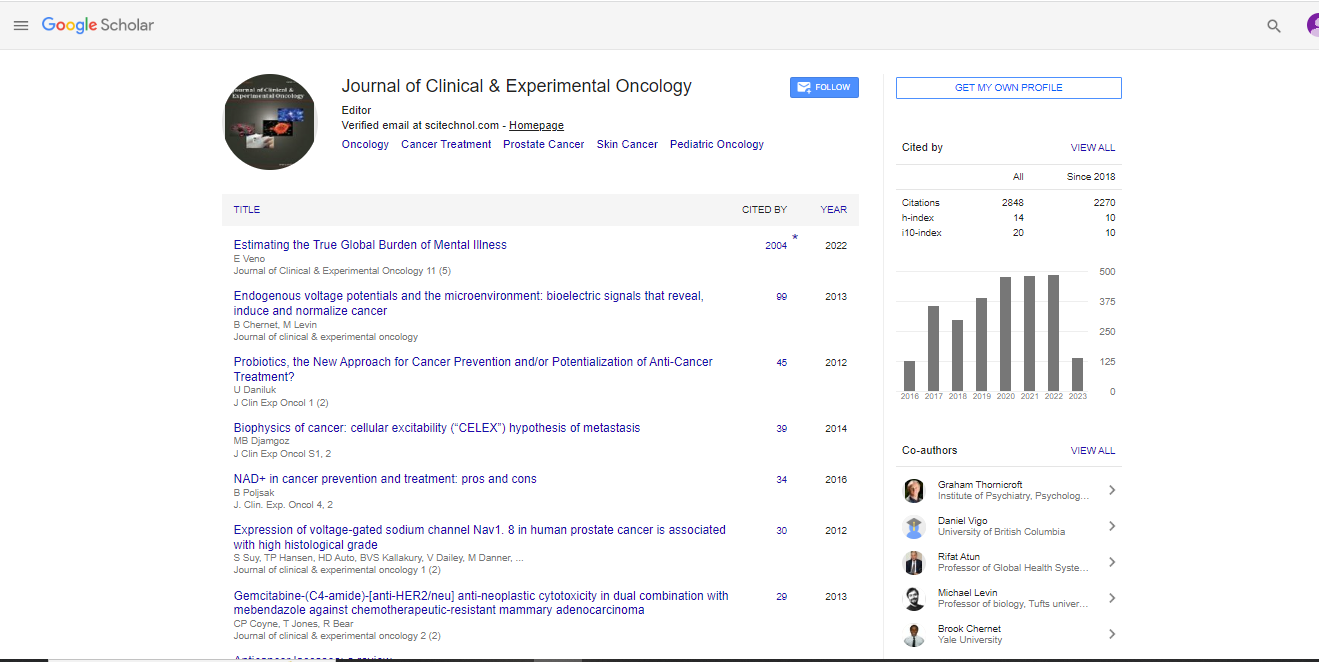Editorial, J Clin Exp Oncol Vol: 2 Issue: 3
Diversifying Graduate Education: The Future of Experimental Oncology
| Mark A. Brown1,2,3* | |
| 1Flint Cancer Center, Department of Clinical Sciences, Colorado State University | |
| 2Department of Ethnic Studies, Colorado State University | |
| 3Alliance for Graduate Education for the Professoriate, Colorado State University | |
| Corresponding author : Mark A. Brown 801 Oval Drive, Campus Code 1052, #146, Fort Collins, CO 80523-1052 Tel: (970) 491-5782; Fax: (970) 491-3483; E-mail: M.Brown@colostate.edu |
|
| Received: April 22, 2013 Accepted: April 26, 2013 Published: May 04, 2013 doi:10.4172/2324-9110.1000e108 | |
| Citation: Brown MA (2013) Diversifying Graduate Education: The Future of Experimental Oncology. J Clin Exp Oncol 2:3. doi:10.4172/2324-9110.1000e108 |
Abstract
Educating future generations of oncology researchers is critical for maintaining and enhancing the development of new therapeutics for the clinical management of cancer. The failure of graduate research programs to recruit and retain diverse pools of students represents a major bottleneck in the preparation of the next generation of cancer researchers. To keep pace with an ever changing and increasingly complex global environment of experimental research, we must all do our part to encourage and support the participation of a diverse body of students in science and technology graduate programs who subsequently enter careers in experimental oncology.
Keywords: Clinical management; Graduate research; Bottleneck
Discussion |
|
| The number of underrepresented minority (URM) students who successfully complete science and technology graduate programs is dismally low. For example, although 24,861 doctoral degrees were awarded in the sciences by universities in the U.S. in 2005, URM students earned only 4.2% of those degrees [1]. Lack of URM student interest in the sciences is among the key factors driving these disproportionate outcomes. Overall, approximately 30% of U.S. students identify an interest in pursuing a science or technology degree. However among URM populations, only 17% of students report an interest in such degrees [2]. It is widely acknowledged that student engagement and diverse mentors are essential to successful diversity recruitment programs [3]. Therefore, it is critical that academic programs address these factors by enhancing URM student engagement and increasing the diversity among their science faculty. | |
| Experience has shown that if students do not feel engaged within the context of their science program, they will leave their programs prematurely. Therefore, it is essential that science programs support rich undergraduate experiences that encourage real scientific practice and discourse coupled with student engagement in a community that respects, welcomes, and promotes diversity. Student learning communities and peer study groups are examples of effective methods for social engagement while co-enrollment in a research seminar and involvement in laboratory research are examples of academic engagement. Among such student engagement initiatives, undergraduate research experiences have been proven to increase student interest, persistence, retention, and graduation in science disciplines. Why, then, do so few undergraduates receive exposure to research laboratories? As faculty researchers, it is paramount that we do our part to provide opportunities for undergraduates to participate in mentored inquiry and research. Although undergraduates require a great deal of training and direct mentoring to be effective in a laboratory research setting, this practice is well worth the investment if we are to sustain our discipline. What good are the strides we make today if there is no future generation to put our findings into practice? | |
| A recent study in higher education reported that the number of URM students who enroll at a given university is proportional to the number of URM faculty at that institution [4]. If URM faculty researchers are not well represented in the sciences, how are URM graduate students to find role models? Science departments must improve their faculty recruiting practices with a more concerted effort placed on recruitment of new URM faculty. This, in turn, will support a pipeline of URM students completing science degrees and entering the professoriate where they will act as mentors for the next generation of URM students. | |
| The lack of diversity in science and technology graduate programs is not an issue that can be remedied by student affairs programs, alone. This is a disciplinary problem and the solution will require active participation and commitment from all of us. A diverse population of students and faculty who participate in our graduate programs is the future of experimental oncology. | |
Acknowledgements |
|
| This work was supported by funding to Mark A. Brown from the National Science Foundation (1060548). | |
References |
|
|
 Spanish
Spanish  Chinese
Chinese  Russian
Russian  German
German  French
French  Japanese
Japanese  Portuguese
Portuguese  Hindi
Hindi 



